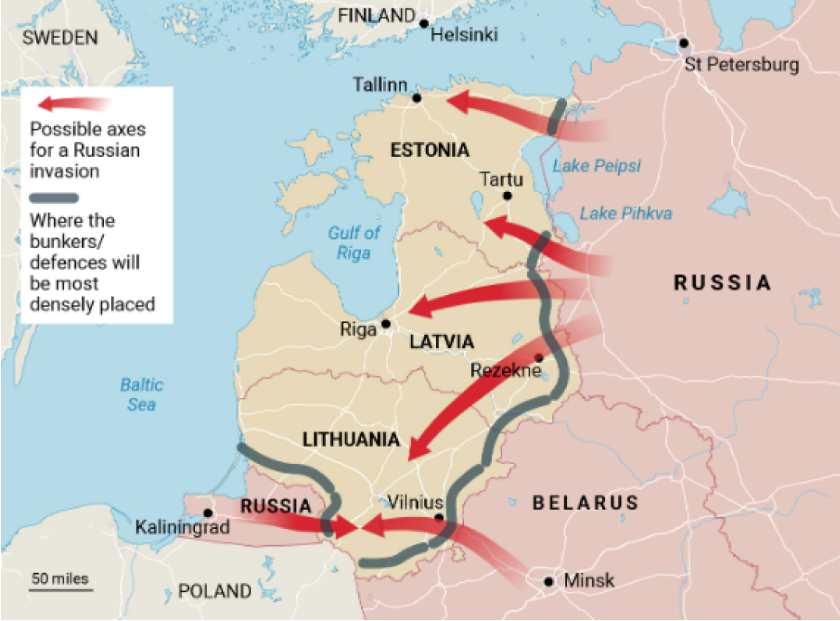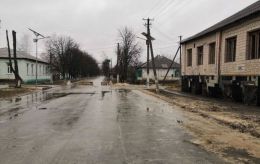Baltic countries fortify eastern borders and prepare for Russian invasion - The Times
 Photo: the Baltic countries are building a line of fortifications to protect against the invasion of the Russian Federation (wikimedia.org)
Photo: the Baltic countries are building a line of fortifications to protect against the invasion of the Russian Federation (wikimedia.org)
The Baltic States are actively preparing for a potential invasion by the Russian Federation and strengthening the thousands of kilometers of their eastern borders. This segment is considered the most vulnerable part of NATO's military flank, informs The Times.
The military forces of Lithuania, Latvia, and Estonia are fortifying their borders with the so-called Baltic Defense Line. It consists of barriers, bunkers, fortifications, and over a thousand concrete bunkers. The fortified border will separate the Baltic countries from Russia, Belarus, and the militarized Russian enclave of Kaliningrad.
In particular, Estonia plans to spend around 60 million euros on constructing 600 such defensive structures along its border with Russia. Susan Lilleväli, Undersecretary for Defence Readiness of the country, mentioned that each bunker will have an area of approximately 37 square meters, accommodating about 10 soldiers, and will be protected against artillery strikes. Additionally, ammunition depots, anti-tank mines, trenches, barbed wire, and concrete pyramids known as dragon's teeth will be positioned nearby.

Translation: Source: The Times (thetimes.co.uk)
Estonian military is implementing a high-intensity project due to concerns about a potential Moscow attack on the Baltic countries. On Tuesday, February 13, Estonia's Foreign Intelligence Service warned in its annual report that Russia intends to double the number of troops near the borders of the three countries, surpassing the 19,000 personnel previously concentrated in the region before the full-scale invasion of Ukraine.
The intelligence report also outlines the Kremlin's plans to create a new army corps, possibly based in Petrozavodsk, northeast of St. Petersburg, to cover the border with Finland.
A Lithuanian army officer and a researcher at the Baltic Institute of Advanced Technologies in Vilnius, Donatas Palavenis, noted that the main purpose of these fortifications is to slow down the advancement of invading forces and redirect them to areas where NATO can counteract them on more favorable terms.
Palavenis states that the construction of this fortified line will require time and resources, but its effectiveness is evident in the war in Ukraine, where forces are unable to effectively breach obstacles and capture significant territory.
He also added that since the Baltic countries lack a depth of defense to delay the enemy, the struggle will be fought for every centimeter of territory, requiring the creation of artificial obstacles and fortifications to minimize losses. According to the Estonian Ministry of Defense's estimates, capturing such positions would require attackers four to seven times more personnel without such fortifications.
According to the sources, the Baltic countries are particularly interested in preventing Russia from establishing its defense on any captured territory. Experts closely study the war in Ukraine, analyzing the reasons for the unsuccessful Ukrainian counteroffensive and the factors preventing the Russian army from advancing to the country's center.
They assure that all sorts of countermeasures are in place: trenches, rows of dragon's teeth, minefields.
Experts also added that the main lesson is to find ways to halt the advance of Russian armored units, as if they cannot be stopped, it will prevent the defense of all the countries.
Threat of Russian invasion to the Baltic countries
Recently, the head of Estonia's Foreign Intelligence Service, Kaupo Rosin, stated that Russia is preparing for a military confrontation with the West within the next decade. This assessment is based on Moscow's plans to double the number of troops deployed along the border with Finland, as well as with the Baltic countries.
The head of NATO's Military Committee, Admiral Rob Bauer, declared that the Alliance needs transformation, and the West must prepare for an era where anything can happen at any time, including the onset of war.
Meanwhile, in Lithuania, a local resident found a Russian hydrolocator on the seashore, designed for collecting reconnaissance information.
In Poland and the Baltic region, significant disruptions in GPS systems were recently recorded. It is not ruled out that this is a result of testing Russian electronic warfare (EW) systems.

